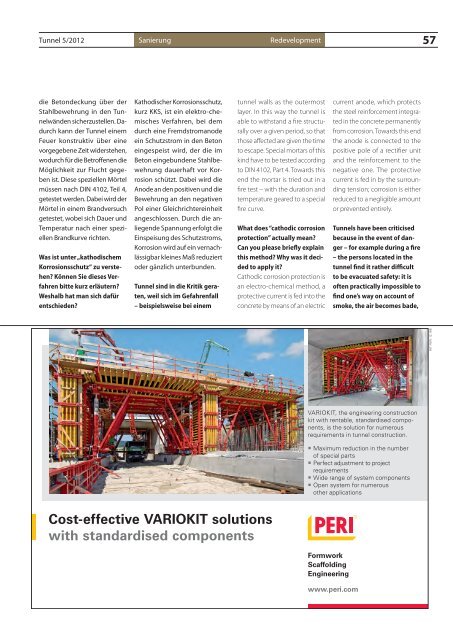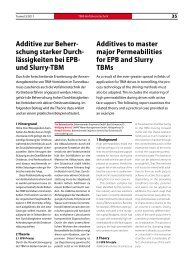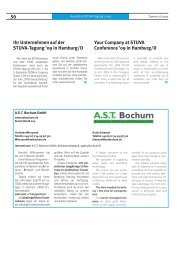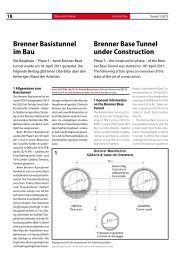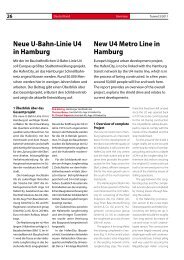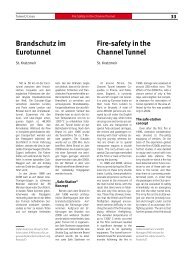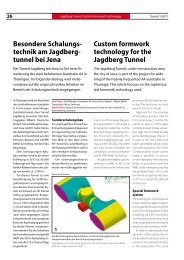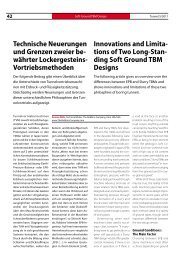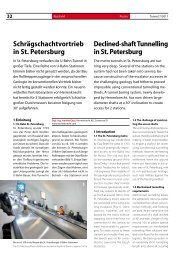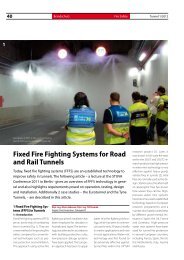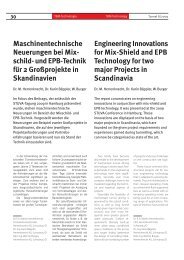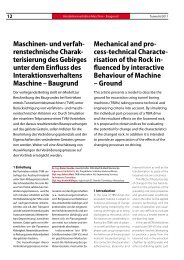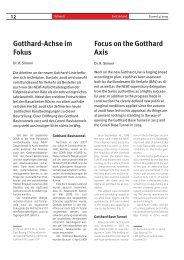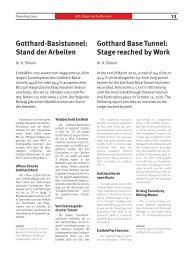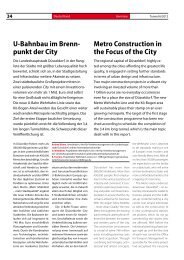Deutsches tunnel-Forum 2012
Deutsches tunnel-Forum 2012
Deutsches tunnel-Forum 2012
Erfolgreiche ePaper selbst erstellen
Machen Sie aus Ihren PDF Publikationen ein blätterbares Flipbook mit unserer einzigartigen Google optimierten e-Paper Software.
Tunnel 5/<strong>2012</strong><br />
die Betondeckung über der<br />
Stahlbewehrung in den Tunnelwänden<br />
sicherzustellen. Dadurch<br />
kann der Tunnel einem<br />
Feuer konstruktiv über eine<br />
vorgegebene Zeit widerstehen,<br />
wodurch für die Betroffenen die<br />
Möglichkeit zur Flucht gegeben<br />
ist. Diese speziellen Mörtel<br />
müssen nach DIN 4102, Teil 4,<br />
getestet werden. Dabei wird der<br />
Mörtel in einem Brandversuch<br />
getestet, wobei sich Dauer und<br />
Temperatur nach einer speziellen<br />
Brandkurve richten.<br />
Was ist unter „kathodischem<br />
Korrosionsschutz“ zu verstehen?<br />
Können Sie dieses Verfahren<br />
bitte kurz erläutern?<br />
Weshalb hat man sich dafür<br />
entschieden?<br />
Sanierung Redevelopment 57<br />
Kathodischer Korrosionsschutz,<br />
kurz KKS, ist ein elektro-chemisches<br />
Verfahren, bei dem<br />
durch eine Fremdstromanode<br />
ein Schutzstrom in den Beton<br />
eingespeist wird, der die im<br />
Beton eingebundene Stahlbewehrung<br />
dauerhaft vor Korrosion<br />
schützt. Dabei wird die<br />
Anode an den positiven und die<br />
Bewehrung an den negativen<br />
Pol einer Gleichrichtereinheit<br />
angeschlossen. Durch die anliegende<br />
Spannung erfolgt die<br />
Einspeisung des Schutzstroms,<br />
Korrosion wird auf ein vernachlässigbar<br />
kleines Maß reduziert<br />
oder gänzlich unterbunden.<br />
Tunnel sind in die Kritik geraten,<br />
weil sich im Gefahrenfall<br />
– beispielsweise bei einem<br />
Cost-effective VARIOKIT solutions<br />
with standardised components<br />
<strong>tunnel</strong> walls as the outermost<br />
layer. In this way the <strong>tunnel</strong> is<br />
able to withstand a fire structurally<br />
over a given period, so that<br />
those affected are given the time<br />
to escape. Special mortars of this<br />
kind have to be tested according<br />
to DIN 4102, Part 4. Towards this<br />
end the mortar is tried out in a<br />
fire test – with the duration and<br />
temperature geared to a special<br />
fire curve.<br />
What does “cathodic corrosion<br />
protection” actually mean?<br />
Can you please briefly explain<br />
this method? Why was it decided<br />
to apply it?<br />
Cathodic corrosion protection is<br />
an electro-chemical method, a<br />
protective current is fed into the<br />
concrete by means of an electric<br />
Formwork<br />
Scaffolding<br />
Engineering<br />
current anode, which protects<br />
the steel reinforcement integrated<br />
in the concrete permanently<br />
from corrosion. Towards this end<br />
the anode is connected to the<br />
positive pole of a rectifier unit<br />
and the reinforcement to the<br />
negative one. The protective<br />
current is fed in by the surrounding<br />
tension; corrosion is either<br />
reduced to a negligible amount<br />
or prevented entirely.<br />
Tunnels have been criticised<br />
because in the event of danger<br />
– for example during a fire<br />
– the persons located in the<br />
<strong>tunnel</strong> find it rather difficult<br />
to be evacuated safety: it is<br />
often practically impossible to<br />
find one’s way on account of<br />
smoke, the air becomes bade,<br />
VARIOKIT, the engineering construction<br />
kit with rentable, standardised components,<br />
is the solution for numerous<br />
requirements in <strong>tunnel</strong> construction.<br />
��Maximum reduction in the number<br />
of special parts<br />
� Perfect adjustment to project<br />
requirements<br />
� Wide range of system components<br />
��Open system for numerous<br />
other applications<br />
www.peri.com<br />
INT PERI 12.166


